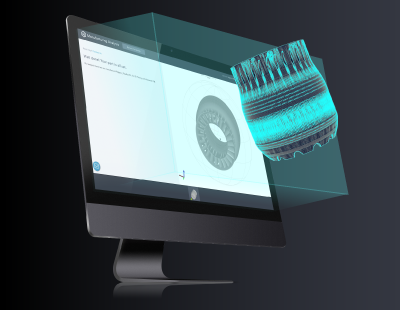Zeroing in on which of our six 3D printing technologies you want to use is totally dependent on your project needs, part applications, material selection, and overall desired aesthetic. Two of our most popular 3D printing services, stereolithography (SLA) and selective laser sintering (SLS) offer engineering-grade options for parts.
Before we dive into the options and benefits, let’s look at how each technology works.

Process Differences Between SLA and SLS
Stereolithography (SLA): With SLA, a laser unit bounces an ultraviolet (UV) beam off of a reflective mirror. The machine’s Galvo Motor System steers the focused beam to the design surface. The laser system first draws support structure layers, followed by actual part geometry. The UV laser solidifies and cures the liquid thermoset resin one layer at a time. After solvent processing to remove any additional resin, the support structures are removed manually.
Selective Laser Sintering (SLS): SLS is a powder bed fusion additive process. A laser sinters each layer of part geometry using a bed of material-based powder. After each layer, a roller distributes the next layer of powder, and this process is repeated layer-by-layer until the build is complete. Finally, the part is manually removed from the powder and bead blasted in post-processing.
How SLA Works
How SLS Works
Analysing Application Needs
Some common applications for parts made via SLA include cosmetic prototypes with a smooth surface finish, parts requiring high dimensional accuracy and intricate detail, and large parts. However, if durability is a key factor, SLS will likely be the more fitting process.
SLS builds accurate prototypes and functional product parts, fast. One consideration to keep in mind: With SLS 3D printing, no support structures are required allowing for the option to include multiple parts into a single build; an economical solution when you need a large volume of 3D-printed parts.
Material Options for SLA and SLS
SLA materials are considered photopolymers, or thermoset resins that are in liquid form. SLA boasts the broadest selection of 3D-printable plastics with an impressive range of mechanical properties. Some of our thermoplastic-like materials include:
- ABS-like
- Polypropylene-like
- Polycarbonate-like
SLS materials originate as thermoplastic powders. In comparison to SLA materials, SLS material can build durable end-use parts. Some options include:
- General purpose nylons (PA 12 Smooth White)
- Filled materials (PA12 Carbon-filled Smooth Black, PA12 40% Glass-filled Smooth White)
- Specialty materials (TPU 88-A Pure Black)
SLA vs. SLS Surface Finishes
In general, parts made using SLA offer smoother surface finishes compared to SLS- parts. Here are the options we offer for finished SLA parts:
|
Unfinished |
Dots, or standing"nibs," remain evident on the bottom of the part from the support structure remnants. |
|
Natural |
Supported surfaces are sanded down to eliminate the support nibs. |
|
Standard |
Supported surfaces are sanded, and the entire part is finely blasted for a consistent look. Note that the layers are still present. |
Surface finishes on SLS parts are typically rougher than SLA or other 3D printing technologies, but this service provides parts that are more durable and better suited for heat or chemical resistance. SLS also works well if flexibility or dimensional stability is needed.

3D Printing Surface Finish Guide
Our 3D Printing surface finish guide provides you with a quick overview of our finishing options and what you can expect when your 3D-printed parts arrive.
3DP Surface Finish Guide
Final Considerations for Choosing Between SLA and SLS
Certain considerations like durability, resolution, or part size may make the decision for you when deciding between SLA or SLS 3D printing. Refer to the table below to see which process tends to win out over the other based on key factors.
Durability and Strength: In general SLS builds more durable, higher strength parts due to the engineering-grade materials available and the fact that they are actual thermoplastics being sintered.
Surface Finish: SLA will build parts with high quality, smoother surface finishes that more closely resemble an injection-molded parts.
Resolution: SLA provides higher resolution compared to SLS. Our SLA 3D printing service offers three resolution options so you can balance detail and surface finish quality with cost.
Tolerances: SLA will be capable of achieving tighter tolerances compared to SLS.
Part Size: Our SLA printers have a larger build envelope than our SLS machines.
Heat and Chemical Resistance: Thermoplastic SLS materials will have better overall heat and chemical resistance than SLA parts.
We’ve covered a lot of ground here. Know that you’re not alone when you’re navigating and deciding which 3D printing process best suits your part needs. Our applications engineers are well-versed at helping you through the process, from design to finished part. Be sure to check out our design tips on stereolithography and selective laser sintering for more useful tips and tricks.

Get an online 3D printing quote today.
Get Instant Quote




